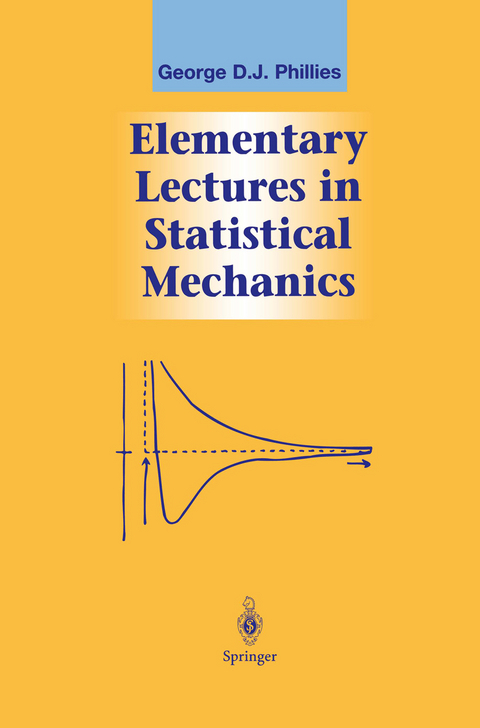
Elementary Lectures in Statistical Mechanics
Springer-Verlag New York Inc.
978-0-387-98918-1 (ISBN)
This volume is based on courses on Statistical Mechanics which I have taught for many years at the Worcester Polytechnic Institute. My objective is to treat classical statistical mechanics and its modem applications, especially interacting particles, correlation functions, and time-dependent phenomena. My development is based primarily on Gibbs's ensemble formulation. Elementary Lectures in Statistical Mechanics is meant as a (relatively sophis ticated) undergraduate or (relatively straightforward) graduate text for physics students. It should also be suitable as a graduate text for physical chemistry stu dents. Physicists may find my treatment of algebraic manipulation to be more explicit than some other volumes. In my experience some of our colleagues are perhaps a bit over-enthusiastic about the ability or tendency of our students to complete gaps in the derivations. I emphasize a cyclic development of major themes. I could have begun with a fully detailed formal treatment of ensemble mechanics, as found in Gibbs's volume, and then given material realizations. I instead interleave formal discussions with simple concrete models. The models illustrate the formal definitions. The approach here gives students a chance to identify fundamental principles and methods before getting buried in ancillary details.
I Fundamentals: Separable Classical Systems.- Lecture 1. Introduction.- Lecture 2. Averaging and Statistics.- Lecture 3. Ensembles: Fundamental Principles of Statistical Mechanics.- Lecture 4. The One-Atom Ideal Gas.- Aside A. The Two-Atom Ideal Gas.- Lecture 5. N-Atom Ideal Gas.- Lecture 6. Pressure of an Ideal Gas.- Aside B. How Do Thermometers Work—The Polythermal Ensemble.- Lecture 7. Formal Manipulations of the Partition Function.- Aside C. Gibbs’s Derivation of.- Lecture 8. Entropy.- Lecture 9. Open Systems; Grand Canonical Ensemble.- II Separable Quantum Systems.- Lecture 10. The Diatomic Gas and Other Separable Quantum Systems.- Lecture 11. Crystalline Solids.- Aside D. Quantum Mechanics.- Lecture 12. Formal Quantum Statistical Mechanics.- Lecture 13. Quantum Statistics.- Aside E. Kirkwood-Wigner Theorem.- Lecture 14. Chemical Equilibria.- III Interacting Particles and Cluster Expansions.- Lecture 15. Interacting Particles.- Lecture 16. Cluster Expansions.- Lecture 17. ? via the Grand Canonical Ensemble.- Lecture 18. Evaluating Cluster Integrals.- Lecture 19. Distribution Functions.- Lecture 20. More Distribution Functions.- Lecture 21. Electrolyte Solutions, Plasmas, and Screening.- IV Correlation Functions and Dynamics.- Lecture 22. Correlation Functions.- Lecture 23. Stability of the Canonical Ensemble.- Aside F. The Central Limit Theorem.- Lecture 24. The Langevin Equation.- Lecture 25. The Langevin Model and Diffusion.- Lecture 26. Projection Operators and the Mori-Zwanzig Formalism.- Lecture 27. Linear Response Theory.- V A Research Problem.- Aside G. Scattering of Light, Neutrons, X-Rays, and Other Radiation.- Lecture 28. Diffusion of Interacting Particles.- Lecture 29. Interacting Particle Effects.- Lecture 30. Hidden Correlations.
| Reihe/Serie | Graduate Texts in Contemporary Physics |
|---|---|
| Zusatzinfo | XVI, 431 p. |
| Verlagsort | New York, NY |
| Sprache | englisch |
| Maße | 155 x 235 mm |
| Themenwelt | Mathematik / Informatik ► Mathematik ► Statistik |
| Naturwissenschaften ► Physik / Astronomie ► Allgemeines / Lexika | |
| Naturwissenschaften ► Physik / Astronomie ► Mechanik | |
| Naturwissenschaften ► Physik / Astronomie ► Thermodynamik | |
| ISBN-10 | 0-387-98918-8 / 0387989188 |
| ISBN-13 | 978-0-387-98918-1 / 9780387989181 |
| Zustand | Neuware |
| Haben Sie eine Frage zum Produkt? |
aus dem Bereich


